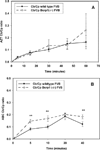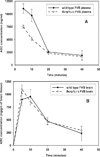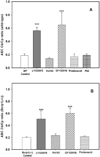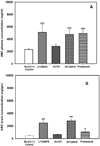Investigation of the role of breast cancer resistance protein (Bcrp/Abcg2) on pharmacokinetics and central nervous system penetration of abacavir and zidovudine in the mouse
- PMID: 18443033
- PMCID: PMC5091086
- DOI: 10.1124/dmd.108.020974
Investigation of the role of breast cancer resistance protein (Bcrp/Abcg2) on pharmacokinetics and central nervous system penetration of abacavir and zidovudine in the mouse
Abstract
Many anti-human immunodeficiency virus 1 nucleoside reverse-transcriptase inhibitors have low central nervous system (CNS) distribution due in part to active efflux transport at the blood-brain barrier. We have previously shown that zidovudine (AZT) and abacavir (ABC) are in vitro substrates for the efflux transport protein breast cancer resistance protein (Bcrp) 1. We evaluated the influence of Bcrp1 on plasma pharmacokinetics and brain penetration of zidovudine and abacavir in wild-type and Bcrp1-deficient (Bcrp1-/-) FVB mice. There was no difference in either area under the concentration-time profiles for plasma (AUC(plasma)) or brain (AUC(brain)) for zidovudine between the wild-type and Bcrp1-/- mice. The AUC(plasma) of abacavir was 20% lower in the Bcrp1-/- mice, whereas the AUC(brain) was 20% greater. This difference resulted in a 1.5-fold increase in abacavir brain exposure in the Bcrp1-/- mice. The effect of selective and nonselective transport inhibitors on the ABC brain/plasma ratio at a single time point was evaluated. 3-(6-Isobutyl-9-methoxy-1,4-dioxo-1,2,3,4,6, 7,12,12a-octahydropyrazino[1',2':1,6]pyrido[3,4-b]indol-3-yl)-propionicacid tert-butyl ester (Ko143), N[4[2-(6,7-dimethoxy-3,4-dihydro-1H-isoquinolin-2-yl)ethyl]phenyl]-5-methoxy-9-oxo-10H-acridine-4-carboxamide (GF120918), probenecid, and Pluronic P85 increased abacavir plasma concentrations in the wild-type mice. Abacavir plasma concentrations in Bcrp1-/- mice were increased by (R)-4-((1aR,6R,10bS)-1,2-difluoro-1,1a,6,10b-tetrahydrodibenzo (a,e)cyclopropa(c)cycloheptan-6-yl)-alpha-((5-quinoloyloxy)methyl)-1-piperazineethanol trihydrochloride (LY335979), GF120918, and probenecid, but not by Ko143. Brain/plasma concentration ratios in both the wild-type and Bcrp1-/- mice were increased by the P-glycoprotein inhibitors LY335979 and GF120918, but not by BCRP-selective inhibitors. These data indicate that deletion of Bcrp1 has little influence on the pharmacokinetics or brain penetration of AZT. However, for abacavir, deletion of Bcrp1 reduces plasma exposure and enhances brain penetration. These findings suggest that Bcrp1 does not play a significant role in limiting the CNS distribution of zidovudine and abacavir; however, brain penetration of abacavir is dependent on P-glycoprotein-mediated efflux.
Figures


 ) MDCKII cells. Results are expressed as means ± S.D.; n = 3. ***, p < 0.001, compared with the wild-type control group.
) MDCKII cells. Results are expressed as means ± S.D.; n = 3. ***, p < 0.001, compared with the wild-type control group.



 , 25 mg/kg LY335979; ▨, 1 mg/kg Ko413; is ▩, 10 mg/kg GF120918; ▤, 200 mg/kg probenecid; ▦, 20 mg/kg Pluronic P85. Results are expressed as means ± S.D.; n = 4. ***, p < 0.001; **, p < 0.01 compared with the respective wild-type controls.
, 25 mg/kg LY335979; ▨, 1 mg/kg Ko413; is ▩, 10 mg/kg GF120918; ▤, 200 mg/kg probenecid; ▦, 20 mg/kg Pluronic P85. Results are expressed as means ± S.D.; n = 4. ***, p < 0.001; **, p < 0.01 compared with the respective wild-type controls.
 , 25 mg/kg LY335979; ▨, 1 mg/kg Ko413; ▩, 10 mg/kg GF120918; ▤, 200 mg/kg probenecid; ▦, 20 mg/kg Pluronic P85. Results are expressed as means ± S.D.; n = 4. ***, p < 0.001. compared with the respective wild-type and Bcrp1−/− controls.
, 25 mg/kg LY335979; ▨, 1 mg/kg Ko413; ▩, 10 mg/kg GF120918; ▤, 200 mg/kg probenecid; ▦, 20 mg/kg Pluronic P85. Results are expressed as means ± S.D.; n = 4. ***, p < 0.001. compared with the respective wild-type and Bcrp1−/− controls.
 , 25 mg/kg LY335979; ▨, 1 mg/kg Ko413; ▩, 10 mg/kg GF120918; ▤, 200 mg/kg probenecid; ▦, 20 mg/kg Pluronic P85. Results are expressed as means ± S.D.; n = 4. ***, p < 0.001; **, p < 0.01 compared with the respective Bcrp1−/− controls.
, 25 mg/kg LY335979; ▨, 1 mg/kg Ko413; ▩, 10 mg/kg GF120918; ▤, 200 mg/kg probenecid; ▦, 20 mg/kg Pluronic P85. Results are expressed as means ± S.D.; n = 4. ***, p < 0.001; **, p < 0.01 compared with the respective Bcrp1−/− controls.Similar articles
-
P-glycoprotein-mediated active efflux of the anti-HIV1 nucleoside abacavir limits cellular accumulation and brain distribution.Drug Metab Dispos. 2007 Nov;35(11):2076-85. doi: 10.1124/dmd.107.017723. Epub 2007 Aug 20. Drug Metab Dispos. 2007. PMID: 17709369
-
Abcg2/Bcrp1 mediates the polarized transport of antiretroviral nucleosides abacavir and zidovudine.Drug Metab Dispos. 2007 Jul;35(7):1165-73. doi: 10.1124/dmd.106.014274. Epub 2007 Apr 16. Drug Metab Dispos. 2007. PMID: 17437964
-
P-glycoprotein and breast cancer resistance protein influence brain distribution of dasatinib.J Pharmacol Exp Ther. 2009 Sep;330(3):956-63. doi: 10.1124/jpet.109.154781. Epub 2009 Jun 2. J Pharmacol Exp Ther. 2009. PMID: 19491323
-
Substrate-dependent breast cancer resistance protein (Bcrp1/Abcg2)-mediated interactions: consideration of multiple binding sites in in vitro assay design.Drug Metab Dispos. 2009 Mar;37(3):560-70. doi: 10.1124/dmd.108.022046. Epub 2008 Dec 4. Drug Metab Dispos. 2009. PMID: 19056916 Free PMC article.
-
P-glycoprotein and breast cancer resistance protein: two dominant transporters working together in limiting the brain penetration of topotecan.Clin Cancer Res. 2007 Nov 1;13(21):6440-9. doi: 10.1158/1078-0432.CCR-07-1335. Clin Cancer Res. 2007. PMID: 17975156
Cited by
-
Treating viruses in the brain: Perspectives from NeuroAIDS.Neurosci Lett. 2021 Mar 23;748:135691. doi: 10.1016/j.neulet.2021.135691. Epub 2021 Jan 30. Neurosci Lett. 2021. PMID: 33524474 Free PMC article. Review.
-
Influence of breast cancer resistance protein and P-glycoprotein on tissue distribution and excretion of Ko143 assessed with PET imaging in mice.Eur J Pharm Sci. 2018 Mar 30;115:212-222. doi: 10.1016/j.ejps.2018.01.034. Epub 2018 Jan 31. Eur J Pharm Sci. 2018. PMID: 29360507 Free PMC article.
-
Brain distribution of cediranib is limited by active efflux at the blood-brain barrier.J Pharmacol Exp Ther. 2012 May;341(2):386-95. doi: 10.1124/jpet.111.190488. Epub 2012 Feb 8. J Pharmacol Exp Ther. 2012. PMID: 22323823 Free PMC article.
-
Drug transporters in tissues and cells relevant to sexual transmission of HIV: Implications for drug delivery.J Control Release. 2015 Dec 10;219:681-696. doi: 10.1016/j.jconrel.2015.08.018. Epub 2015 Aug 13. J Control Release. 2015. PMID: 26278511 Free PMC article. Review.
-
Interactions of tenofovir, Lamivudine, abacavir and Didanosine in primary human cells.Pharmaceutics. 2011 Jun 22;3(2):326-37. doi: 10.3390/pharmaceutics3020326. Pharmaceutics. 2011. PMID: 24310499 Free PMC article.
References
-
- Bailer AJ. Testing for the equality of area under the curves when using destructive measurement techniques. J Pharmacokinet Biopharm. 1988;16:303–309. - PubMed
-
- Batrakova EV, Miller DW, Li S, Alakhov VY, Kabanov AV, Elmquist WF. Pluronic P85 enhances the delivery of digoxin to the brain: in vitro and in vivo studies. J Pharmacol Exp Ther. 2001;296:551–557. - PubMed
-
- Bihorel S, Camenisch G, Lemaire M, Scherrmann JM. Modulation of the brain distribution of imatinib and its metabolites in mice by valspodar, zosuquidar and elacridar. Pharm Res. 2007;24:1720–1728. - PubMed
-
- Cooray HC, Blackmore CG, Maskell L, Barrand MA. Localisation of breast cancer resistance protein in microvessel endothelium of human brain. Neuroreport. 2002;13:2059–2063. - PubMed
-
- Cordon-Cardo C, O’Brien JP, Boccia J, Casals D, Bertino JR, Melamed MR. Expression of the multidrug resistance gene product (P-glycoprotein) in human normal and tumor tissues. J Histochem Cytochem. 1990;38:1277–1287. - PubMed
Publication types
MeSH terms
Substances
Grants and funding
LinkOut - more resources
Full Text Sources

